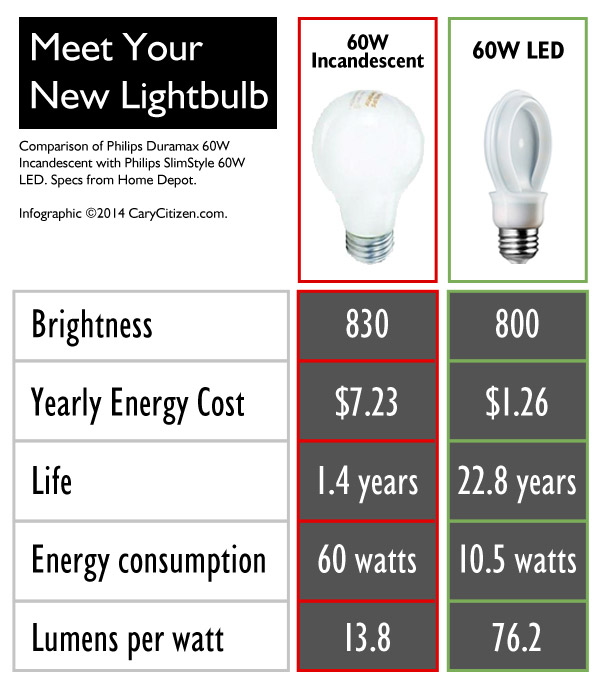Tech: Say Hello to Your New Lightbulb
Cary, NC — Say goodbye to those 40 and 60 watt incandescent bulbs. As of January 1 of this year, they can no longer be manufactured or imported into the U.S. Say hello to the SlimStyle LED bulb. It might be the future of how you light your home.
A Brief History of the Lightbulb
 We all know how a lightbulb works – an electrical current is applied to a thin wire, or filament, causing it to heat up and glow (incandescence). The hot filament is enclosed in a bulb of glass filled with inert gases to keep the wire from burning up.
We all know how a lightbulb works – an electrical current is applied to a thin wire, or filament, causing it to heat up and glow (incandescence). The hot filament is enclosed in a bulb of glass filled with inert gases to keep the wire from burning up.
The first demonstration of the principle of incandescence was in 1802 by Humphrey Davy at the Royal Institution in Great Britain. Thomas Edison filed his first patent for “Improvement in Electrical Lights” in 1878.
The lightbulb has seen incremental improvements since 1878, but the principle is still the same – a burning wire in a bulb of glass.
Say Goodbye to the Old Lightbulb
The problem with incandescent lighting is that it is terribly inefficient. Up to 95% of the energy is wasted in the generation of heat (source: Wikipedia).
Lots of alternatives exist, but old habits die hard. To encourage the retirement of Edison’s lightbulb, the government phased out the manufacture or import of 40 and 60 watt incandescent bulbs, effective January 1, 2014. You may still find them on store shelves for a while, but it’s time to say goodbye.
Say Hello to the New Lightbulb
Does this mean you’ll be forced to switch to those twisty new CFLs? Maybe not.
Just in time, Philips has released a new flat lightbulb called the SlimStyle. It’s powered by a tiny horseshoe of LEDs.
Here’s a comparison of costs, energy usage and other specs between two 60 watt bulbs from Philips – one a standard incandescent, the other a new SlimStyle LED.
The new SlimStyles have been introduced at a price of about $10 a bulb. A four-pack of SlimStyle LEDs at Home Depot is $37.88. A four-pack of 60W incandescents is $1.97.
On initial purchase price, SlimStyle LEDs are about 14x more expensive than incandescents. But take a look at the price of ownership.
Creative Destruction and the Wheel of Capitalism
Here’s a strange observation to ponder: the light bulb has become a consumer durable. A few boxes of CFLs or LEDs is enough to last a quarter century.
On the other hand, my appliances, TV and even automobiles seem to last a decade or less. Don’t even get me started on phones.
I bought an eight-pack of CFLs about ten years ago and have only replaced one bulb in all that time.
What used to be an item on the grocery list has gone extinct. There’s a technology story to brighten your day.
———————————————————————————————-
Edison lightbulb from The Franklin Institute.






I purchased my Cree bulbs at Home Depot. I’m not sure who else in the area carries them. The 60W equivelants come in ‘Soft White’ and ‘Daylight’ versions.
I’m happy to hear about the new LED lamp bulb. While I want to be a good citizen of this planet, those CFL bulbs were hard to get used to and gives me headaches. I’ve also broken a couple and worried about the mercury and breathing in the gases from those bulbs since I already have damage to my central nervous system and immune system from in eutero exposure to DES.
I am also an Interior Designer, and I do wish that LED and CFL bulbs came in softer colors. The blueish tint from the light is not as flattering to the skin or easy on the eyes. Tricks from my trade to make living/bedrooms and private offices more inviting is to use colors that make the inhabitants look their best as well as using tinted lamp bulbs and gold/silver lamp shades.
I recently moved to a gorgeous new townhouse community in Cary, and have had a hard time decorating around those CFL bulbs. I’m definitely going to check out the LED lights ASAP.
IKEA has sold LED under cabinet lights, pendant lamps, etc. for several years now. I bought some in Chicago for my mom to exchange her incredibly expensive halogen lamps for back in 2001. LED lights are great for work area lights.
I’m also interested in the CREE bulbs, but this article is the first place I’ve heard about them. Where can these be purchased?
We have many of same original incandescent bulbs in our house for past 22 years. Line voltage is around 110-120 volts. Our builder installed 130V Lifetime brand bulbs. We never seem to replace any!
Today’s version is called Aero-tech and they claim 20,000 hour life.
None of the mercury disposal hassles of a CFL, too.
The power supplies for LED flood lamps for outdoor use radiate a bunch of radio frequency interference, heard on my ham radios. FCC enforcement of that mess will be a nightmare in the future, especially if they affect communications for LEO, EMS, ATC, etc.
Hint: find a portable radio that has AM, go off-station and walk up to a suspected source and listen for the buzzing!
Interesting article, however, this is misleading information. There is no such thing as an incandescent light bulb ban in the United States. In fact, on Jan 1, 2014 when the 60-watt incandescent light bulb disappeared, we are still able to buy a 43-watt incandescent light bulb to take its place. Or a 72-watt incandescent bulb. Or a 150-watt incandescent bulb. Or a three-way incandescent light bulb. Or one with a more durable filament for “rough service” applications. There are literally dozens of loopholes.
The so-called bulb ban is simply a government-mandated energy efficiency standard at work. Seven years ago, President Bush [yes this was his fault] signed the Energy Independence and Security Act of 2007 into law, and its final light bulb provisions took effect 1/1/2014. The law simply requires that the most popular light bulbs are roughly 25 percent more efficient — that you only need 43 watts to generate the same amount of light as a 60-watt incandescent.
But WAIT, there’s more!
On Jan 15, 2014, the US House of Reps passage of a $1.1 trillion spending bill, dictated the budgets for all federal agencies and it may be a desperately needed lifeline for the lightbulb. The bill included a prohibition on funding for “the administration’s onerous ‘lightbulb’ standard”.
The Energy and Water Appropriations section of the bill now prohibits funds to implement or enforce the higher efficiency lightbulb standards.
So basically, they made it illegal to enforce the previous law!
ONLY Washington could squirt out tripe of this caliber!
“None of the funds made available in this act may be used … to implement or enforce the standards established by the tables contained in section 325(i)(1)(B) of the Energy Policy and Conservation Act,” reads section 322 of the bill.
For what it’s worth, I have a Cree LED bulb burning right next to me and I love it! It has a 30 year warranty, and I have the original receipt as well as a soft copy scan of it.
No flicker. These are LED bulbs, not CFL’s. Completely different technology.
I am not a fan of the CFL light bulbs. My eyes are very sensitive to the flicker. I end up with a headache if I am around them too much. I wonder if the new SlimStyles have the same flicker.
Personally, having tried both, I prefer the Cree (located in Cary) bulbs to the Philips. They generally cost a little less too.